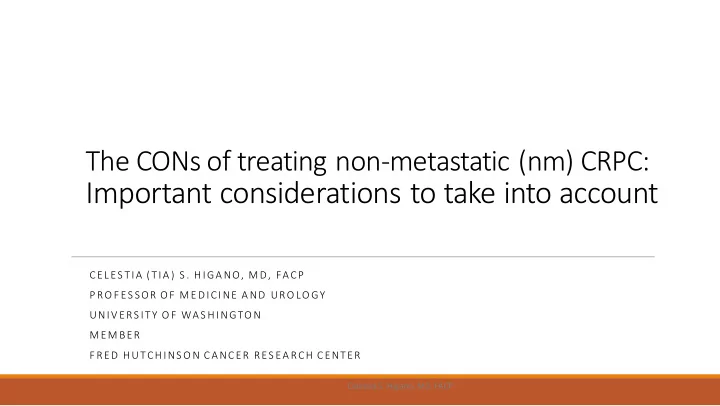

The CONs of treating non-metastatic (nm) CRPC: Important considerations to take into account CEL ES TIA (TIA) S . HIGANO, M D, FACP P RO F ES SOR O F M ED ICINE AND URO LO GY UNIV ERS ITY O F WAS HINGTO N M EM BER F RED HUTCHINS O N CANCER RES EARCH CENTER Celestia S. Higano, MD, FACP
Disclosures Grant or research support : Aptevo, Aragon, Astellas, AstraZeneca, Bayer, Hoffman LaRoche, Medivation, Pfizer Advisory Board/Steering Committee: Astellas, Bayer, Blue Earth Diagnostics, Clovis Oncology, Ferring, Janssen, Myriad, Tolmar Ownership interest : Spouse former co-founder/Leadership role, CTI Biopharma
What is the definition of nmCRPC? Standard definition: ▪ Serial rising PSAs despite a castrate level of testosterone ▪ No evidence of metastatic disease by conventional imaging: Technetium bone scan, CT chest, abdomen, pelvis Inclusion criteria for clinical trials included only “high risk” nmCRPC ▪ PSA DT ≤ 10 months and ▪ PSA 2 or greater It is important to understand that FDA label does not restrict use of 2 nd gen AA to high risk populations even though lower risk patients were not included
Risk of bone metastases or death for men with nmCRPC based on PSA-DT Howard et al, BJU Int 2017 Smith et al, JCO 2005 Smith et al, JCO 2013
Overview metastases free survival First time this magnitude of difference Active Placebo Agent seen in trials in this population (trial) Median MFS (months) Very substantial difference Apalutamide 40.5 16.2 Even without OS data, difference in (SPARTAN) delaying time to metastasis is Enzalutamide meaningful to patients…as long as 36.6 14.7 (PROSPER) they do not experience substantial toxicity… Darolutamide 40.4 18.4 (ARAMIS) And can afford the price, sometimes up to $10,000/month
Specific toxicities of concern Adve verse eve vent nt Apalutamide de (SPARTAN) N) Enzalut utamide (PROSPER) Darolutamide (ARAM AMIS) Tx vs PBO (%) Tx vs PBO (%) Tx Tx vs PBO (%) Grade 5 AE (death) 1.2 vs 0.3 3 vs 1 3.9 vs 3.2 Fatigue, any 30 vs 21 33 vs 14 12.1 vs 8.7 Fatigue, gr 3-4 0.9 vs 0.3 3 vs 1 0.4 vs 0.9 Asthenia NR 9 vs 6 NR HTN, any 24.8 vs 19 12 vs 5 6.6 vs 5.2 HTN, gr 3-4 14.3 vs 11.8 5 vs 2 3.1 vs 2.2 Falls, any 15.6 vs 9 11 vs 4 NR Falls, gr 3-4 1.7 vs 0.8 1 vs 1 NR Fracture, any 11.7 vs 6.5 Falls and fractures NR 17 vs 8 Fracture, gr 3-4 2.7 vs 0.8 NR
No head to head comparison data ▪ Regarding toxicities and tolerance ▪ Impact on QOL and other functional measures ▪ How underlying co-morbidities are affected - Cardiovascular disease - Hypertension - History of falls or seizure - Frailty - Impact on osteoporosis or osteopenia/fracture
What do we know about the proportion of high vs low risk nmCRPC based on PSA-DT VA patients with nm CRCP (2000-2015) 1 Canadian cohort (2011) 2 PSA-DT N=440 (%) PSA-DT N=1188 < 3 months 33 (7.5) < 8 months 712/1188 (60) 3-8.9 months 128 (29.1) 9-14.9 months 69 (15.7) ≥ 15 months 210 (77.1) ▪ Obviously the proportion of lower risk patients is extremely variable ▪ Treating all patients with nmCRPC with 2 nd gen ART could expose a significant number to longer durations of therapy and thus more potential for toxicity 1. Howard et al, BJU Int 2017 2. Hernandez et al, Can J Urol 2015
How many nmCRPC patients have metastases by PSMA-PET imaging? 200 men with nmCRPC by conventional Clearly, PSMA-PET imaging will identify imaging had PSMA-PET imaging more patients with nmCRPC who have very early M1 CRPC. ◦ M1 disease in 55% 61% had PDA-DT ≤ 10 months Questions: ◦ M0 disease in 46% Should the “M1” nmCRPC patient be 43% had PSA- DT ≤ 10 months treated with therapy for mCRPC or should they be treated with 2 nd gen AA? (no prospective data)? Can PSMA-PET imaging +/- PSA-DT be used to identify patients who could delay systemic therapy and perhaps be treated with SBRT or other salvage approaches? Fendler et all, (in press)
What are the cons of using 2 nd line ART for nmCRPC? There is definitely toxicity at the individual patient level that we don’t yet understand: who will have it and how reversible is it? Long term effect on natural history of mCRPC is unknown: will the more aggressive disease phenotype develop earlier in mCRPC due to longer exposure to ARTs during nmCRPC. Treating men with nmCRPC and longer PSA-DT has a significant risk of doing more harm than good. Safe choice of agent and monitoring of these agents requires urologists to practice internal medicine. There can be significant financial toxicity for those who do not qualify for assistance programs (in US, can be $10,000/month).
Going forward I realize that these 3 trials are strongly positive and that these agents should be used in appropriate men, but I do not believe all nmCRPC patients are suitable candidates for therapy. We will need a better understanding in the post-market setting about the toxicities of these agents relative to each other. Are there genetic, pharmacogenomic, or other biomarkers that can predict these patient specific toxicities? Need to consider the role of conventional imaging in concert with molecular imaging to better characterize the different subtypes of nmCRPC in clinical trials and to determine the role of salvage approaches guided by PSMA-PET in nmCRPC.
Recommend
More recommend